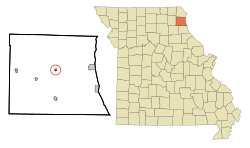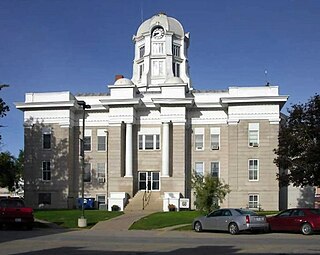
Scotland County is a county in northeastern Missouri. As of the 2020 census, its population was 4,716, making it Missouri's seventh-least populous county. Its county seat is Memphis. The county was organized on January 29, 1841, and named for the country of Scotland.

Lewis County is a county located in the northeastern portion of the U.S. state of Missouri. As of the 2020 census, the population was 10,032. Its county seat is Monticello. The county was organized January 2, 1833 and named for Meriwether Lewis, the explorer and Governor of the Louisiana Territory.

Knox County is a county located in the northeast portion of the U.S. state of Missouri. As of the 2020 census, its population was 3,744, making it the third-least populous county in Missouri. Its county seat is Edina. The county was organized February 14, 1845 and named for U.S. Secretary of War General Henry Knox.
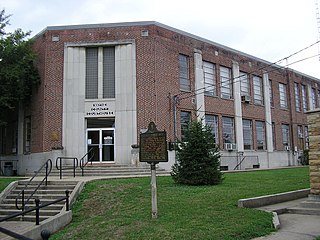
Wayne County is a county in the U.S. state of Kentucky along the southern border with Tennessee. As of the 2020 census, the population was 19,555. Its county seat is Monticello. The county, on the south-central border with Tennessee, was named for Gen. Anthony Wayne, a Revolutionary War hero. As of November 3, 2020, Wayne County is a wet county—a measure allowing the sales and consumption of alcoholic drinks passed by a margin of 4,901 for and 3,966 against.

Monticello is a college town in, and the county seat of, Drew County, Arkansas, United States. As of the 2010 census it had a population of 9,467. Founded in 1849 in the Arkansas Timberlands near the Arkansas Delta region, the city has long been a commercial, cultural and educational hub for southeast Arkansas. With a historically agriculture- and silviculture-based economy, Monticello has diversified to include growth from the medical sector and the University of Arkansas at Monticello (UAM).
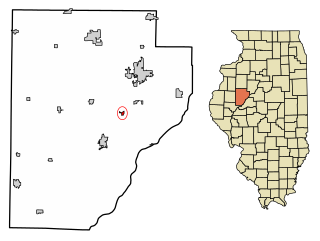
Bryant is a village in Fulton County, Illinois, United States. The population was 168 at the 2020 census, down from 255 at the 2000 census.

Fairview is a village in Fulton County, Illinois, United States. The population was 426 at the 2020 census.

Lewistown is a city in Fulton County, Illinois, United States. It was named by its founder, Ossian M. Ross, after his oldest son, Lewis W. Ross. The population was 2,384 at the 2010 census, down from 2,522 at the 2000 census. It is the county seat of Fulton County. Located in central Illinois, it is southwest of Peoria. It is the source of Spoon River Anthology by Edgar Lee Masters, who lived there. Native American burial mounds are nearby at Dickson Mounds off Illinois Route 97.

Godfrey is a village in Madison County, Illinois, United States. The population was 17,825 at the 2020 census. Godfrey is located within the River Bend portion of the Greater St. Louis metropolitan area.
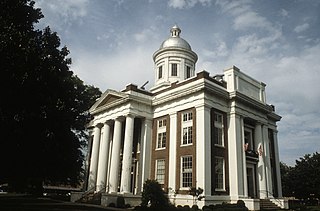
Canton is a city in Madison County, Mississippi, United States. The population was 13,189 at the 2010 census. It is the county seat of Madison County, and situated in the northern part of the metropolitan area surrounding the state capital, Jackson.

Butler is a city in Bates County, Missouri, United States and is part of the Kansas City metropolitan area. The population was 4,219 at the 2010 census. The county seat of Bates County, the city is named for William Orlando Butler, a noted American military and political figure of the early and mid-19th century. It is located approximately 50 mi (80 km) south of Kansas City, Missouri on U.S. Route 71-Interstate 49.
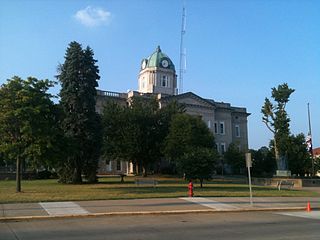
Jackson is a city in and the county seat of Cape Girardeau County, Missouri, United States. It is a principal city of the Cape Girardeau–Jackson, MO-IL Metropolitan Statistical Area. The population of Jackson was 15,481 at the 2020 census.

Salem is the county seat of Dent County, Missouri, United States. The population was 4,608 at the 2020 census, which allows Salem to become a Class 3 city in Missouri; however, the city has chosen to remain a Class 4 city under Missouri Revised Statutes. Salem is located a few miles north of the Ozark Scenic Riverways and close to Montauk State Park, which contains the headwaters of the Current River.

Canton is a city in Lewis County, Missouri, United States. The population was 2,774 at the 2020 census. Canton is the home of Culver-Stockton College, a small liberal arts college affiliated with the Christian Church. It also had the oldest continuously operating ferry across the Mississippi River, which closed in April 2014. Four members of the United States House of Representatives have come from Canton, and are buried in the city's Forest Grove Cemetery. Canton is part of the Quincy, IL–MO Micropolitan Statistical Area.

Lewistown is a city in Lewis County, Missouri, United States. The population was 521 at the 2020 census. It is part of the Quincy, IL–MO Micropolitan Statistical Area. It is located on Missouri Route 6 near the junction of Route 6 with Missouri Route 16. Lewistown is in the Lewis County C-1 school district.

Linneus is a small city in Linn County, Missouri, United States. The population was 281 at the 2020 census. It is the county seat of Linn County.

Doniphan is a city in Ripley County, Missouri, United States. The population was 1,781 at the 2020 census. It is the county seat of Ripley County.

Memphis is a city in and the county seat of Scotland County, on the northern border of Missouri, United States. As of the 2020 census, its population was 1,731. U.S. Highway 136 passes near Memphis, which is east of Lancaster and west of Kahoka.

Thompson is a town in the southern part of Sullivan County, New York, United States. The population was 16,550 at the 2020 census. The town is named after William Thompson, an early settler.

Fabius is a village in Onondaga County, New York, United States. As of the 2020 census, the population was 309. It is part of the Syracuse Metropolitan Statistical Area. The village is near the center of the town of Fabius and is south of Syracuse.

